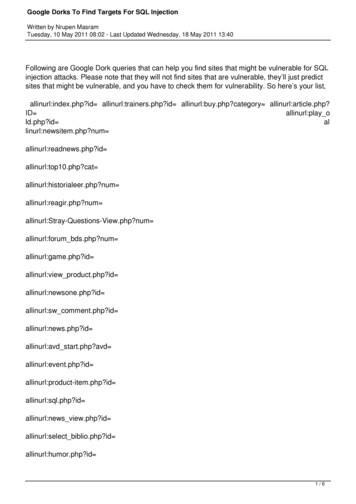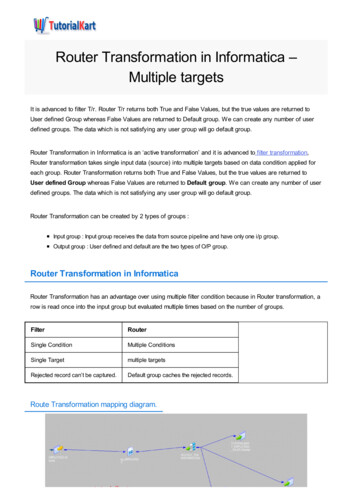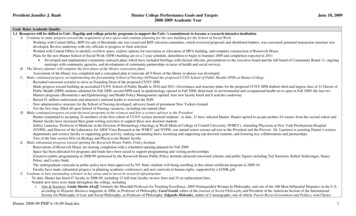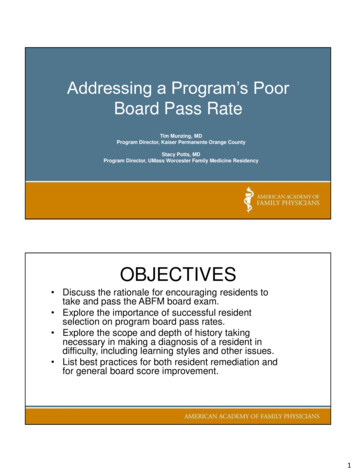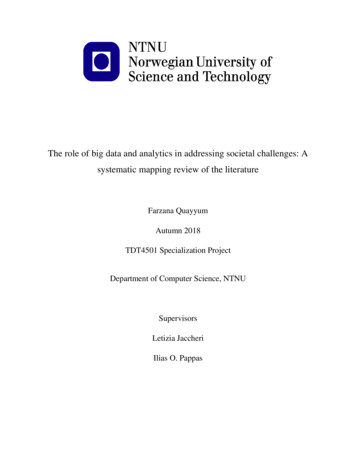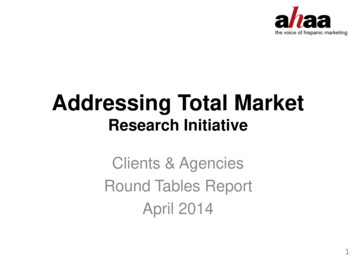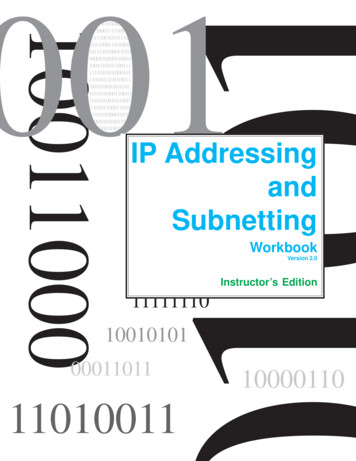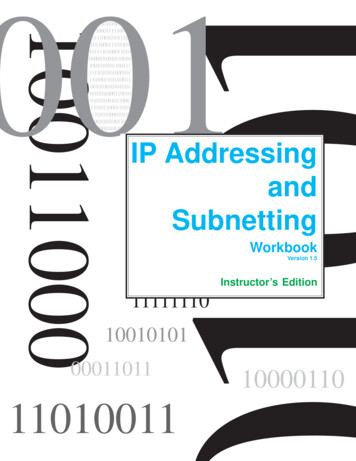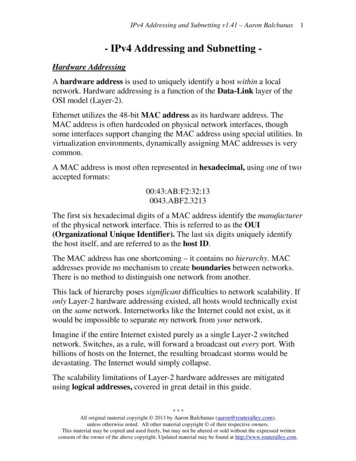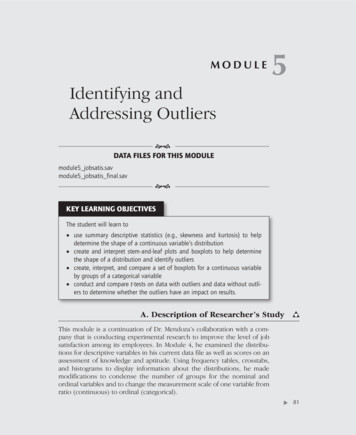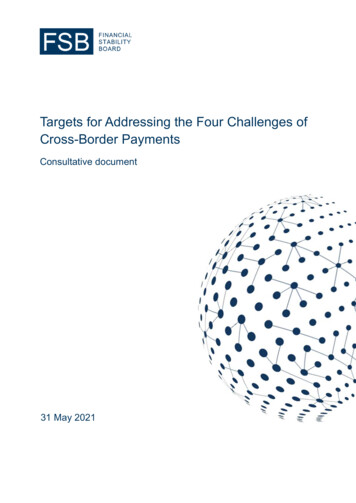
Transcription
Targets for Addressing the Four Challenges ofCross-Border PaymentsConsultative document31 May 2021
The Financial Stability Board (FSB) coordinates at the international level the work of nationalfinancial authorities and international standard-setting bodies in order to develop and promotethe implementation of effective regulatory, supervisory and other financial sector policies. Itsmandate is set out in the FSB Charter, which governs the policymaking and related activities ofthe FSB. These activities, including any decisions reached in their context, shall not be bindingor give rise to any legal rights or obligations.Contact the Financial Stability BoardSign up for e-mail alerts: www.fsb.org/emailalertFollow the FSB on Twitter: @FinStbBoardE-mail the FSB at: fsb@fsb.orgCopyright 2021 Financial Stability Board. Please refer to the terms and conditions
Preface and consultation questionsThe G20 has made enhancing cross-border payments a priority. Faster, cheaper, more transparentand more inclusive cross-border payment services, including remittances, which would havewidespread benefits for citizens and economies worldwide, support economic growth, internationaltrade, global development and financial inclusion. A roadmap was developed by the FSB, incoordination with the Committee on Payments and Market Infrastructures (CPMI) and other relevantinternational organisations and standard-setting bodies to address these challenges.Financial innovation is creating opportunities to make payments more efficient. Innovation intechnology and business models in payments has put the focus on further enhancements in paymentssystems. New technologies have the potential to facilitate fast, low cost, transparent and scalablepayments for a broad range of users through the banking system. Public authorities have an importantrole to play, working with the private sector to leverage opportunities and address challenges in bothexisting and new arrangements supporting cross-border payments.The G20 Leaders endorsed the Roadmap in the form of 19 Building Blocks and related Actions forEnhancing Cross-border Payments 1 at their November 2020 Summit.A foundational step in the Roadmap consists of setting quantitative targets at the global level foraddressing the challenges of cost, speed, transparency and access faced by cross-border payments,which will play an important role in defining the ambition of the work and creating accountability. Theyare intended to provide a common vision for the improvements that are being sought through thecollaborative work of the private and public sectors. These targets are being set in an inclusivemanner, including through this public consultation.This consultation document (i) describes the principles, and key design features underpinning, thetargets and target metrics; (ii) proposes three market segments for which targets be set across thefour challenges; (iii) considers factors in setting the targets; and (iv) proposes a set of targets that arehigh-level, simple, small in number and focused on end-users.The FSB is inviting comments on this consultation document and the questions set out below.Responses should be sent to fsb@fsb.org by Friday 16 July 2021. Responses will bepublished on the FSB’s website unless respondents expressly request otherwise.1. What are your comments on the key design features applied in designing the targets (section 1)?Are there any design features that you consider are missing?2. Do you agree with the market segments as described? Are they sufficiently clear? Do they reflectthe diversity of cross-border payments markets, while providing a high-level common vision foraddressing the four roadmap challenges?3. Do you have any comments on the target metrics proposed?4. Do you agree with the proposal in the definition of the market segments to separate remittancepayments from other types of cross-border person-to-person (P2P) payments because of thegreater challenges that remittances in some country corridors face? If so, can you suggest datasources that can distinguish between the two types?5. Are the proposed numerical targets suitable? Are they objective and measurable, so thataccountability can be ensured by monitoring progress against them over time?6. What are your views on the cost target for the retail market segment? Does it reflect anappropriate level of ambition to improve on current costs while taking into consideration thevariety of payment types within the segment? Should reference transaction amounts be set for1FSB (2020), Enhancing cross-border payments roadmap, October.ii
the target (in the same way as 200 has been set for the current UN Sustainable DevelopmentGroup targets for remittances) and, if so, what amount would you suggest?7. What are your views on the speed targets across the three market segments? Are the proposedtargets striking the right balance between the ambition of having a large majority of users seeingsignificant improvements, the recognition that different types of user will have different speedrequirements, and the extent of improvements that can be envisaged from the actions plannedunder the roadmap?8. Are the dates proposed for achieving the targets (i.e. end-2027 for most targets) appropriatelyambitious yet achievable given the overall time horizon for the Actions planned under theRoadmap? Would an alternative and more ambitious target date of end-2026 be feasible?9. What data sources exist (or would need to be developed) to monitor the progress against thetargets over time and to develop and set key performance indicators? Do you have relevant datathat you would be willing to share for this purpose either now or during the future monitoring?10. Do you have further suggestions or questions about the detailed definition and measurement ofthe targets and their implementation? Which types of averages can be constructed to help tomeasure progress?11. Do you have any suggestions for more qualitative targets that could express ambitions for thebenefits to be achieved by innovation that would be in addition to the proposed quantitativetargets for the payments market as a whole?iii
Table of ContentsExecutive summary . 1Introduction . 31.Objectives and key design features for the cross-border payments targets . 42.Market segment definitions . 43.4.2.1.Wholesale payments . 52.2.Retail payments (involving non-financial corporates or public sector entities aspayers or receivers and other P2P payments). 52.3.Remittances . 6Factors to be considered in setting the targets for the four challenges . 63.1.Cost . 63.2.Speed . 73.3.Access . 83.4.Transparency . 10Proposed targets in detail . 114.1.Wholesale payments targets . 114.2.Retail payments (B2B/ P2B/ other P2P) targets . 114.3.Remittance targets . 12iv
v
Executive summaryA foundational step in the G20 Roadmap for Enhancing Cross-border Payments consists ofsetting quantitative targets at the global level for addressing the challenges of cost, speed,transparency and access faced by cross-border payments. The targets will play an importantrole in defining the ambition of the work, creating accountability. Measuring progress over timein meeting the targets will help to indicate whether the existing roadmap actions are sufficient oradditional actions may be needed.The FSB proposes here for public consultation a set of targets based on the following principles:the targets should be directly related to the challenges, provide a clear indication of the extentof progress, be appropriately ambitious, be able to be readily communicated, and be meaningfulto the wide range of stakeholders. Targets would be set at a global level. Additionally, the taskforce agreed on key design features, which are included under section 1.The proposed targets are based on a consideration of the current payment landscape andpublicly available data from multiple sources for the four challenges across three marketsegments – wholesale, retail (e.g. business-to-business (B2B)/ person-to-business (P2B)business-to-person (B2P)/ person-to-person (P2P) payments (other than remittances)), and (asa separate category from other P2P payments) remittances. This split between remittances andother P2P payments is proposed in recognition of the greater challenges and frictions that somepayment corridors in the remittance market face.By the time of the October final report on the targets, the FSB will also develop an implementationapproach for monitoring the targets that will set out (i) how targets will be measured and datasources and data gaps to be filled, (ii) how progress toward meeting the targets will be monitoredand (iii) the frequency of data collection and publication. A wide set of stakeholders will beconsulted in this process to gain their insights, learn from their practical expertise and to assistas a key source of data. Their involvement will be key to monitoring improvements over time.End-2027 is proposed as a common target date across the individual targets, with the exceptionof the remittance cost target, where a 2030 date has already been set as a United NationsSustainable Development Goal (UN SDG) and endorsed by the G20. 2 As detailed in theRoadmap, the indicative timelines for the actions in the individual building blocks in the Roadmapextend through 2025. The end-2027 target date provides a six-year period during which actionsunder the Roadmap will be taken and stakeholders will be operationalising the changes toinfrastructures and operations as follow-up. As a result, it is anticipated that the improvementsset out in the targets can be credibly achieved on behalf of end-users through the implementationof the Roadmap. Stakeholders who are able to pursue faster implementation are encouraged todo so. A phased approach to setting further, more ambitious targets after 2027 could also beadopted to aim for additional further improvements over time and take into account marketdevelopments that take place over the coming years.The proposed targets for the four challenges (cost, speed, transparency and access) across thethree market segments are as nces-day/background and 1
Table 1: Proposed targets for the Cross-Border Payments RoadmapChallenge34567Payment SectorWholesaleRetail (e.g. B2B, P2B/ B2P,other P2P 3)RemittancesCostNo target set 4Global average cost ofpayment to be no more than1%, with no corridors withcosts higher than 3% by end2027Reaffirm UN SDG:Global average cost ofsending 200 remittanceto be no more than 3%by 2030, with nocorridors with costshigher than 5%SpeedLarge majority (e.g.75%) of cross-borderwholesale payments tobe within one hour ofpayment initiation 5, byend-2027 and for theremainder of the marketto be within onebusiness dayLarge majority (e.g. 75%) ofpayments to provideavailability of funds for therecipient within one hour fromthe time the payment isinitiated 6, by end-2027 and forthe remainder of the market tobe within one business dayLarge majority (e.g.75%) of remittancepayments in everycorridor to provideavailability of funds forthe recipient within onehour of paymentinitiation 7 by end-2027and for the remainder ofthe market to be withinone business dayAccessAll financial institutions(including financialsector remittanceservice providers) in allpayment corridors tohave at least one option(in terms ofinfrastructures andproviders) and, whereappropriate, multipleoptions for sendingcross-border wholesalepayments by end-2027All end-users (individuals,businesses (including MSMEs)or banks) to have at least oneoption (in terms ofinfrastructures and providers)for sending or receiving crossborder electronic payments byend-2027More than 90% ofindividuals (includingthose without bankaccounts) who wish tosend or receive aremittance payment tohave access to a meansof cross-borderelectronic remittancepayment by end-2027TransparencyAll payment service providers to provide at a minimum a defined list of informationconcerning cross-border payments to payers and payees (including e.g. totaltransaction cost (showing FX rate and currency conversion charges), time to deliverfunds, funds tracking, and terms of service) by end-2027“Other P2P” refers to P2P payments other than remittances.Due to the difficulty of estimating average costs across in the wholesale market where transactions are typically not individuallypriced, it is proposed not to set a target for this segment, see section 4.1.For this purpose, a wholesale payment is considered initiated at the moment of entry into a payment infrastructure orcorrespondent bank as defined by their applicable rules.For this purpose, a retail or remittance payment is considered initiated when the payment order is received by the payer’spayment service provider.See footnote 6.2
IntroductionThe G20 made enhancing cross-border payments a priority during the Saudi ArabianPresidency. Faster, cheaper, more transparent and more inclusive cross-border paymentservices, including remittances, while maintaining their safety and security, would havewidespread benefits for citizens and economies worldwide, supporting economic growth,international trade, global development and financial inclusion.In October 2020, the FSB published the Roadmap for enhancing cross-border payments. TheRoadmap was developed in coordination with the Committee on Payments and MarketInfrastructures (CPMI) and other relevant international organisations and standard-settingbodies. The Roadmap was endorsed by the G20 at the October 2020 Summit and the G20 hascommitted to its timely and effective implementation.The Roadmap 8 described four challenges to be addressed: High costs: the challenge of cost comprises various elements including transactionfees, account fees, compliance costs, applied FX conversion rates and fees, fees alongthe payment chain, and liquidity cost for prefunding; Low speed: the challenge of speed involves the processing time of a payment fromend to end, including factors such as the time required for dispute resolutions,reconciliations and searches, possible slow processes for funding and defunding, dailycut-off times and closing times, as well as Anti-Money Laundering/ Combating theFinancing of Terrorism (AML/CFT) checks; Limited access: the challenge includes limitations for users in accessing services andfor PSPs in accessing payment systems and other arrangements; Limited transparency: limited transparency about costs, speed, processing chain, andpayments status present challenges for end-users and (other than single-platformproprietary services) for providers alike.A foundational action under the Roadmap is to reinforce momentum, by setting specificquantitative targets for addressing the four challenges for endorsement at the October 2021 G20Summit. This will establish a shared understanding of the targeted improvements in users’experience with cross-border payments and act as a commitment mechanism to drive change.These targets will therefore need to be monitored and publicly reported on over time.The FSB established the Cross-border Payments Coordination Group Task Force on Targets(CPC-TFT), composed of senior FSB representatives, to develop a proposal for specificquantitative targets including target dates for a public consultation to be launched in May 2021.8See FSB Report (2020), Enhancing Cross-border Payments - Stage 1 report to the G20: Technical background report, April.3
1.Objectives and key design features for the cross-borderpayments targetsThe targets have been set in line with the following principles: they are directly related to thechallenges, provide a clear indication of progress, are appropriately ambitious, can be readilycommunicated and are meaningful to the wide range of stakeholders.The targets have been developed with the following design features in mind:2. Direct and meaningful relationship to the four challenges to be addressed. Theproposed targets relate to each of the challenges: cost, speed, access andtransparency and are designed to be meaningful across the diverse range of crossborder payment types and uses. The overall number of targets should be small. Setting only a small number oftargets enables stakeholders to have a clear focus on achieving these targets. Targets should be simple. The Roadmap is intended to remain flexible in how itaddresses the four challenges. Targets that avoid excessive granularity support suchflexibility in how the overall goals are achieved. Targets should focus on end-user experience. Targets that focus on end-users aredirectly meaningful to the users of financial services. Target dates should be set for achieving the goals. Clear target dates are key foraccountability. Targets should be quantitative whenever possible, in order to be able to objectivelymeasure whether or not they have been achieved. Targets will be set at the global level, and progress should be objectivelymeasured at the global level (and, where appropriate, at regional levels). For thispurpose, a set of key performance indicators would need to be developed, withappropriate public or private sector data sources identified that either already exist or,if necessary and if the costs are justified by the benefits, developed. International targets for remittances set as a UN SDG have already been agreedto and endorsed by the G20, and should remain.Market segment definitionsGlobally, the ecosystem supporting cross-border payments is diverse and multi-layered. Crossborder payments are often categorised as retail or wholesale. These segments differ greatly interms of volume and values of transactions performed, and the payment arrangements typicallyused. The targets that are set for them should therefore differ.It is proposed that targets be set for three market segments: wholesale, retail and remittances(as defined further below). This approach would facilitate setting goals that address the4
challenges for different types of end-users and purposes of transactions. However, in order tokeep targets small in number and simple in design, the market is not further segmented beyondthat.For the purposes of this paper, the end-user is defined as the ultimate payer or receiver of fundsin a transaction: this could be an individual, a business, a public sector entity, or a financialinstitution.2.1.Wholesale paymentsWholesale payments between financial institutions are by far the majority of the total crossborder payments market by value, being typically high value/ low volume interbank payments,often
Financial innovation is creating opportunities to make payments more efficient. Innovation in technology and business models in payments has put the focus on further enhancements in payments systems. New technologies have the potential t
